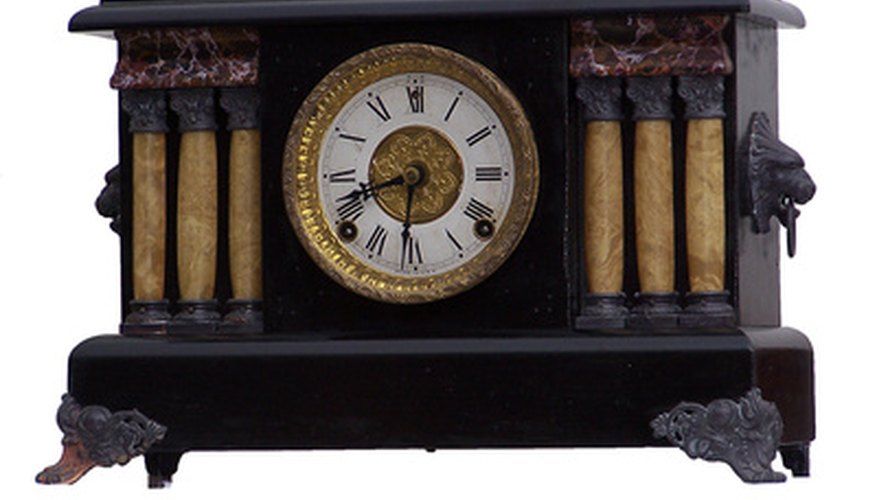Replacing the movement in a mantel clock can done by anyone with moderate mechanical skills and a minimal amount of tools. There are myriad case designs that fall into the mantel clock category, so before removing a movement find out which kind of new clock movement will be a suitable replacement for the old one. It is also necessary to consider the chime mechanism feature of the clock, whether it is a striking clock that counts the hours or a quarter-hour chiming clock, such as a Westminster, before beginning.
Remove the pendulum (if applicable) from the suspension rod by lifting it up and out of the mantel clock case.
- Replacing the movement in a mantel clock can done by anyone with moderate mechanical skills and a minimal amount of tools.
- Remove the pendulum (if applicable) from the suspension rod by lifting it up and out of the mantel clock case.
Remove the minute-hand nut by holding the minute-hand near its centre and turning the nut counterclockwise. If the nut is too tight to remove with your fingers, use the pliers to remove it. Take care not to allow the jaws of the pliers to slip over the knurled edges of the nut. If the minute hand is secured with a wedge pin and washer, remove the pin using the needle nose pliers.
Remove the hour hand from its shaft by gripping its base and pulling while turning the hand slightly in either direction. The hour hand is a friction-fitted hand and should come free without difficulty.
Remove the movement mounting bracket screws from inside the mantel clock case using the appropriate screwdriver. There will be a bracket in each corner of the movement with one or two screws holding each bracket to the wood of the case.
- Remove the hour hand from its shaft by gripping its base and pulling while turning the hand slightly in either direction.
- Remove the movement mounting bracket screws from inside the mantel clock case using the appropriate screwdriver.
Remove the mantel clock movement from its case.
Remove the nut that secures the mounting brackets from each corner of the movement using the combination pliers. Take note of the position of each of the brackets for the purpose of installation of the new movement.
Install the mounting brackets in each corner of the new mantel clock movement by removing each corner nut and tighten with your fingers with each bracket in its previously noted position.
Place the new movement into the mantel clock case and align each of the winding arbors and the hand shaft so that they are centred in their respective holes in the dial pan.
Align each of the corner brackets with the screw holes in the mantel clock case. Check the winding arbor and hand shaft positions in the dial pan each time.
Remove the clock movement from the case and tighten the bracket screws with the combination pliers.
Install the new movement into the mantel clock case and tighten one screw in diagonal corners from each other with the screwdriver. Check again for proper alignment of the winding arbors and the hand shaft.
- Install the mounting brackets in each corner of the new mantel clock movement by removing each corner nut and tighten with your fingers with each bracket in its previously noted position.
- Install the new movement into the mantel clock case and tighten one screw in diagonal corners from each other with the screwdriver.
Place the remaining screws in the mounting brackets and tighten with the screwdriver.
Install the hour hand on the hour shaft using light finger pressure at the circular base of the hand.
Install the minute hand on its arbor and secure the nut tightening with your fingers only, or install the washer and wedge pin with the needle nose pliers, whichever applies.
Install the minute hand on its arbor and secure the nut, tightening with your fingers only, or install the washer and wedge pin with the needle nose pliers, whichever applies.
TIP
Battery-operated mantel clock movements can be removed by unscrewing the retaining nut with the pliers after taking off the hands as mentioned in Step 2, after which the movement can be removed from the back of the clock case. Reverse this process to install a new movement.
